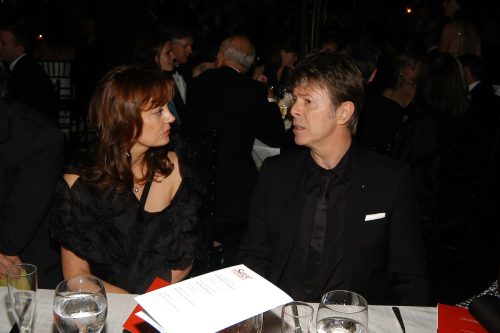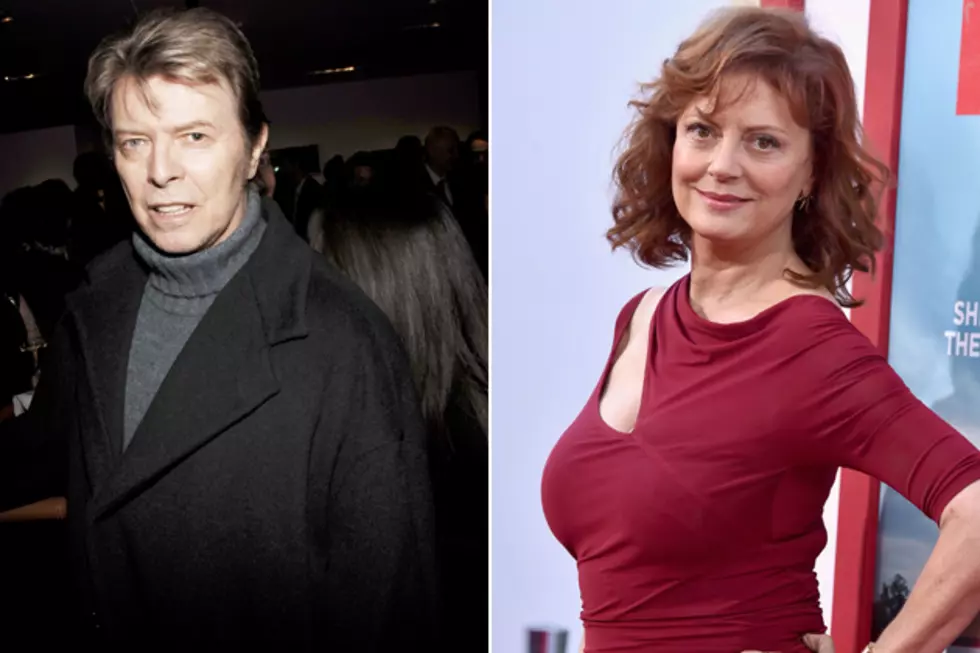Can two seemingly disparate worlds the glam rock stratosphere and the silver screen's dramatic heights truly converge to leave an enduring legacy? The answer, as the stories of David Bowie and Susan Sarandon reveal, is a resounding yes. Their intertwined lives, forged in the crucible of creativity and fueled by a shared commitment to social consciousness, offer a fascinating case study in the power of art and activism.
The cultural landscape has been forever altered by the unique artistry and unwavering commitment of David Bowie and Susan Sarandon. These two icons, though operating in distinct spheres, found common ground in their willingness to challenge conventions, embrace individuality, and champion causes they believed in. Their paths, though not always running parallel, intersected in ways that enriched both their personal lives and the broader cultural narrative. From the mesmerizing stage presence of Bowie to the captivating performances of Sarandon, their legacies intertwine, offering a testament to the enduring power of creativity and the importance of using one's platform for positive change.
| Attribute | David Bowie | Susan Sarandon |
|---|---|---|
| Full Name | David Robert Jones | Susan Abigail Tomalin |
| Born | January 8, 1947, Brixton, London, England | October 4, 1946, Jackson Heights, Queens, New York |
| Died | January 10, 2016, New York City, New York | Living |
| Occupation(s) | Singer, songwriter, actor, record producer, visual artist | Actress, producer, activist |
| Known For | Groundbreaking music, iconic stage personas (Ziggy Stardust, etc.), influential acting roles | Acclaimed performances in films like "Thelma & Louise," "Dead Man Walking," and outspoken political activism |
| Key Works/Roles | Albums: "The Rise and Fall of Ziggy Stardust and the Spiders from Mars," "Heroes," "Let's Dance"; Films: "The Man Who Fell to Earth," "Labyrinth" | "Joe" (1970), "The Rocky Horror Picture Show" (1975), "Atlantic City" (1980), "Thelma & Louise" (1991), "Dead Man Walking" (1995) |
| Political Affiliation/Activism | Known for his artistic expressions of social commentary, though not as overtly political in his public persona as Sarandon. | Actively involved in progressive causes, including human rights, LGBTQ+ rights, and anti-war movements. |
| Relationship to each other | Starred together in the 1983 film "The Hunger." Brief romantic relationship. | Starred together in the 1983 film "The Hunger." Brief romantic relationship. |
| Reference Website | davidbowie.com | IMDb - Susan Sarandon |
Susan Sarandon's journey began in Jackson Heights, Queens, New York, on October 4, 1946. Her upbringing in a Catholic household and her attendance at Catholic schools provided a foundation that would later inform her views on social justice and her willingness to question societal norms. She transitioned from a quieter life into the exciting world of acting in the late 1960s, steadily climbing the ranks and gaining recognition for her work. Her career launched in the early 1970s with her role in the film "Joe" (1970), marking the beginning of a distinguished filmography that would showcase her versatility and her dedication to complex, often morally ambiguous characters. Sarandon's choices reflected a desire to take on roles that challenged her and the audiences, and over the decades she became a celebrated figure in the film industry, known for the powerful, nuanced performances she brought to the screen.
- Discover The Pop Out Ken The Ultimate Fashion Doll For Boys
- The Ultimate Guide To The Names Of Buzz Aldrins Wives
David Bowie, born David Robert Jones in Brixton, London, on January 8, 1947, was a force of nature, a shapeshifting visionary whose music, style, and theatricality redefined the boundaries of rock and pop. His music was a form of exploration, pushing the boundaries of what was possible, and he was at the forefront of an entire generation of artists who were unafraid to experiment. Bowie's career was a constant metamorphosis, from the alien glam rock of Ziggy Stardust to the slick funk of "Let's Dance." Each persona, each album, each performance was a calculated act of creation, of reinventing himself and drawing in audiences to engage in his ever-evolving art. His work wasnt just about the music, it was about the total package. His acting, his style, and his artistic collaborations all came together to form an artist who truly had no equal.
The paths of Bowie and Sarandon converged in 1983 with the film "The Hunger," a visually stunning and sensual vampire tale. The film itself served as a crucible, where their artistic visions could meet, creating a unique experience. Beyond the professional, a brief romantic relationship blossomed, a private interlude that would later be revealed by Sarandon. The relationship, though short-lived, offers a glimpse into the lives of two people who, at that point, were at the pinnacle of their respective fields. They were both living complex lives that reflected the freedom and experimentation of the time.
The film "The Hunger" is a key example of how the worlds of Bowie and Sarandon intersected, showcasing their creative synergy. Their connection extended beyond the film set, offering a glimpse into a time where they both embraced a period of intense creative output, challenging artistic boundaries, and exploring personal connections. The film's influence on the culture still resonates. Bowie's musical contributions were integral to the tone and atmosphere of the movie, which allowed both artists to flourish creatively. The project was a success because of the individuals involved, and their unique vision brought to the project.
- Unmissable Playoff Bracket For Major League Soccer
- The Journey Of Brittney Griners Transitioning A Story Of Strength And Transformation
Their shared history highlights a world of creativity and individuality, a world where artistic expression was valued, and where personal boundaries were continually pushed. Sarandon's openness in discussing the relationship, specifically her reflections in 2014 and after Bowie's death in 2016, revealed a mutual respect and admiration. It showcased a deep connection that transcended the brevity of their time together.
The "Thelma & Louise" star, reflecting on the passing of her former partner, has opened up about their final phone call, an intimate moment that reveals the depth of their shared experience. These moments shed a human light on two giants of the creative world, reminding us that even legends are human, and that even the most powerful among us have moments of shared vulnerability. This candidness and honesty provide a valuable perspective on the nature of celebrity, art, and loss.
The film society of Lincoln Center hosted a gala in honor of Susan Sarandon, where the presence of David Bowies wife, Iman, and other luminaries further underscored the impact of their combined influence. The event at Avery Fisher Hall, within the Lincoln Center in New York, was a celebration of Sarandon's contributions to film and her dedication to humanitarian causes. The event was a testament to Sarandon's lasting influence and was a moment of recognition for her decades-long career.
The romantic rendezvous that brought Bowie and Sarandon together came after Sarandon's divorce from her first husband, Chris Sarandon, and before her long-term relationship with actor Tim Robbins. This was a period of personal and professional exploration for both artists. Their paths were intertwined in a moment of intense creative output and public attention. Sarandon's willingness to embrace new experiences and her capacity to form deep connections became defining characteristics of this period in her life. The fact that their paths crossed at such a pivotal time in their lives suggests that they valued the opportunity to be in the same circles.
Their lasting legacies include their artistic contributions, but also their outspoken advocacy for social justice. Both used their platforms to voice their opinions, support causes they believed in, and inspire others to do the same. Their careers reflect the fusion of artistic expression and social responsibility, a legacy that continues to influence generations. Their ability to use their platform to amplify the voices of the marginalized is an integral part of who they were as artists and people. The ongoing relevance of their work shows the importance of artists who are both creative and socially aware.
The enduring impact of David Bowie and Susan Sarandon underscores the power of art and activism. They showed the world that these two elements are not mutually exclusive, and, in fact, can be mutually reinforcing. Their lives serve as an inspiration to anyone who believes in the power of art to create, to challenge, and to advocate. Their enduring legacy is a testament to the lasting impact of people who dared to be different, who used their talent for good, and who left a mark on the world.

:max_bytes(150000):strip_icc():gifv():focal(587x207:589x209)/susan-sarrandon-1-63f7e7d0d7c84e56aa3114df41466ac5.jpg)

Detail Author:
- Name : Prof. Gail Keeling
- Username : kpaucek
- Email : zwitting@schmeler.com
- Birthdate : 1984-06-13
- Address : 977 Marlee Underpass Suite 354 Lake Marielashire, NY 33512-9865
- Phone : +1-812-407-7125
- Company : Jones-Cartwright
- Job : Packaging Machine Operator
- Bio : Dolores aut consequatur est. Quaerat nostrum blanditiis facere deleniti esse esse et. Sint occaecati temporibus sed laudantium. Provident repellendus voluptatibus et eum necessitatibus illo.
Socials
linkedin:
- url : https://linkedin.com/in/kaylie2384
- username : kaylie2384
- bio : Recusandae amet cumque et odio dicta iste.
- followers : 1755
- following : 2417
tiktok:
- url : https://tiktok.com/@kaylie_weimann
- username : kaylie_weimann
- bio : Ut doloribus nihil eos voluptatem.
- followers : 4243
- following : 910
facebook:
- url : https://facebook.com/weimannk
- username : weimannk
- bio : Ut dolor nobis velit tempora excepturi.
- followers : 480
- following : 456